Conventional freight management software can no longer suffice in the exponentially growing online marketplace. An on-demand trucking app has emerged as an efficient solution for operations in the logistics industry. These apps give a clear view of what's happening right now, making logistics more effective. Data proves their support in planning, carrying out, and adjusting operations. These logistics products that respond to demand give shippers and carriers a level of flexibility and openness they've never had before.
The market goes through sudden changes, which makes tech leaders see on-demand trucking platforms as something they need to run their operations, not just an extra feature they could add on.
Explore our truck dispatch software solution to see how advanced dispatch systems enhance real-time visibility and routing efficiency.
On-Demand Trucking Market Growth and Digital Freight Trends
The on-demand trucking business model is growing rapidly as companies seek faster and more reliable transportation options. No longer do enterprises depend entirely on brokers or fixed routes. A digital freight platform provides live access to truck availability, capacity, and routes, making it the superior choice for logistics operations.
Modern logistics management software helps make transportation easier and boosts productivity. Today's logistics teams work to cut travel time and match loads better. Systems that work together let shippers and carriers team up without a hitch while getting real-time insights into supply chains.
As more businesses start using these digital systems, they find that smart trucking solutions don't just save money. They also give companies an edge over competitors by changing how goods move across markets.
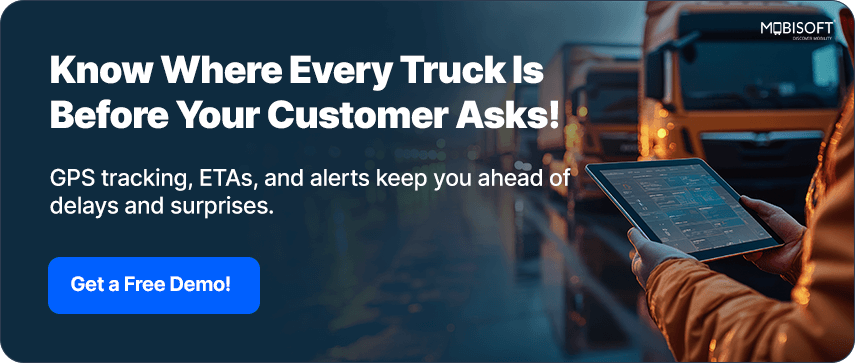
Operational Intelligence in On-Demand Trucking for Smarter Logistics

Modern logistics needs more than just saving money. Companies now use operational smarts to make better choices. On-demand trucking apps help businesses plan routes well, stop delays, and zero in on the parts that matter most.
Predictive analytics allows logistics personnel to predict changes in demand and adjust capacity in advance, rather than react after challenges exist. This data-intensive thinking increases the reliability of deliveries and improves efficiency. Carriers also benefit since they have the potential to route and schedule optimally based on available traffic, load access, and other operational factors.
Companies applying these applications realize that value lies not only in cost reduction strategies but also in overall decision-making and service level improvements. Operational intelligence becomes a core competition foundation in freight handling and allows companies to stay agile and responsive in an ever-fluctuating market.
For businesses planning digital transformation, our transportation and logistics solutions can help streamline operations and optimize performance.
AI, IoT, and 5G Technology Powering Smart Trucking Apps
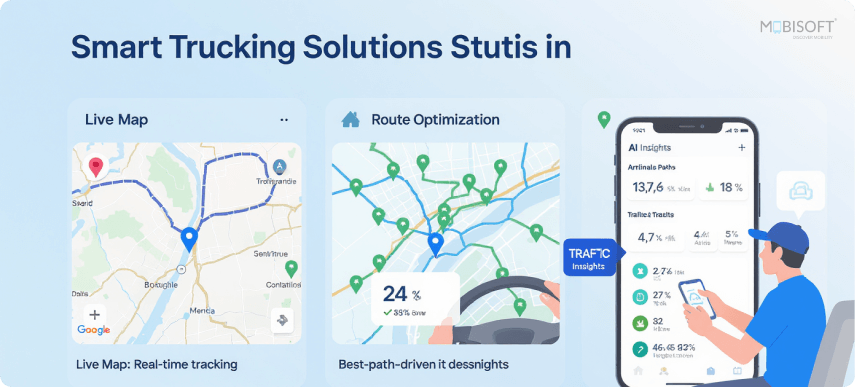
AI-Powered Route Optimization
- Mobile apps based on on-demand trucking make use of AI in planning traffic flows, delivery spots, and load allocations.
- This allows the carrier to make the most efficient route choices, saving fuel and cutting down on time. In real-time, business operations can adapt plans in case of disruptions.
- AI also helps in the forecasting of demand and matching up resources beforehand.
IoT for Real-Time Visibility
- Through trucking software, Sensors in trucks and cargo provide real-time reporting on location, temperature, and load status.
- This increases transparency so that companies respond immediately in case of delays or issues.
- Carriers have enhanced asset control, and shippers know that their cargo is tracked end-to-end.
5G Connectivity and Rapid Data Transfer
- 5G technology supports the massive data transfer required in transportation logistics software.
- It enables vast amounts of data to flow between trucks, control towers, and cloud systems in real-time.
- This accommodates real-time tracking, fast changes, and compatibility with AI analyzing systems.
Integrated Platforms for Freight Intelligence
- On-demand Trucking solutions today combine AI, IoT, and 5G under a single platform.
- Such platforms provide predictive outputs, perform automated tasks regularly, and enhance communication between shippers and carriers.
- Tech-enabled businesses that are integrated realize greater operational efficiency, minimal delay, and effective asset allocation.
In combination, AI, IoT, and 5G aren't supporting aids and assistants; they're the very center of freight intelligence. The firms that utilize them will obviously benefit. They will be able to route more effectively, perceive more, and make smarter, faster business decisions.
To learn more about how technology is reshaping logistics and transportation, explore our insights on the role of technology in transporter operations.
Measuring ROI and Cost Savings
Measuring Efficiency Gains
- Teams can access live data on fuel capacity, delivery times, and traffic, improving the route efficiency.
- Teams can analyze data using these apps to consistently improve the overall experience and remove inefficiencies.
- These features increase customer engagement and, above all, trust in the service, which is of immense value in the long term.
Cost Savings Beyond Fuel and Labor
- Fewer idle miles, better load matching, and schedule optimization create opportunities to reduce overall operational cost.
- Automation of freight management's manual processes also lowers administrative costs.
- Carriers and shippers share these cost reductions equally, adding up to a healthier bottom line throughout the supply chain.
Long-Term Investment Returns
- In addition to frontline cost savings, on-demand trucking apps future-proof operations.
- With advanced predictive analysis, real-time location, and automated planning, companies make sophisticated investments in the fleet and in assets.
- Strategically invested companies have a sustainable advantage and long-term payback on upfront costs.
Measuring the ROI on digital freight is no longer theoretical. On-demand trucking app businesses always experience increased efficiency, cost reduction, and operational insight. Within these solutions, we have proof that smart technology investments make real, measurable payback.
Learn how to select the most effective technology by reading How to choose the right TMS for your logistics business.
Traditional Logistics vs Digital Freight Platforms
Market Share Distribution
The digital-first logistics management software continues to gain market share from older brokers. On-demand trucking apps offer transparency that helps monitor pricing, making it perfect for companies looking to manage expenses. Older systems, often based on conventional freight management software, tend to be rigid and struggle to adapt to changing market conditions.
Modern logistics management software continues to gain market share from legacy brokers. Transparency-driven companies prefer apps offering open schedules and clear pricing, while older systems struggle to adapt to changing market dynamics.
Legacy Broker Challenges
They depend on traditional manual processes and long-term links. Although such networks are valuable, they typically have issues with scalability and velocity. Legacy businesses have longer lead times, higher expenses, and minimal cargo visibility. This void is driving companies toward alternative smart trucking solutions.
Competitive Response and Adaptation
Certain old-school players are investing in digital transformation to remain relevant. They are incorporating technology to automate processes, offer tracking options, and improve customer experience.
Stay ahead of industry disruption by understanding the future of distribution and logistics technology.
Strategic Implementation Guide for On-Demand Trucking Solutions
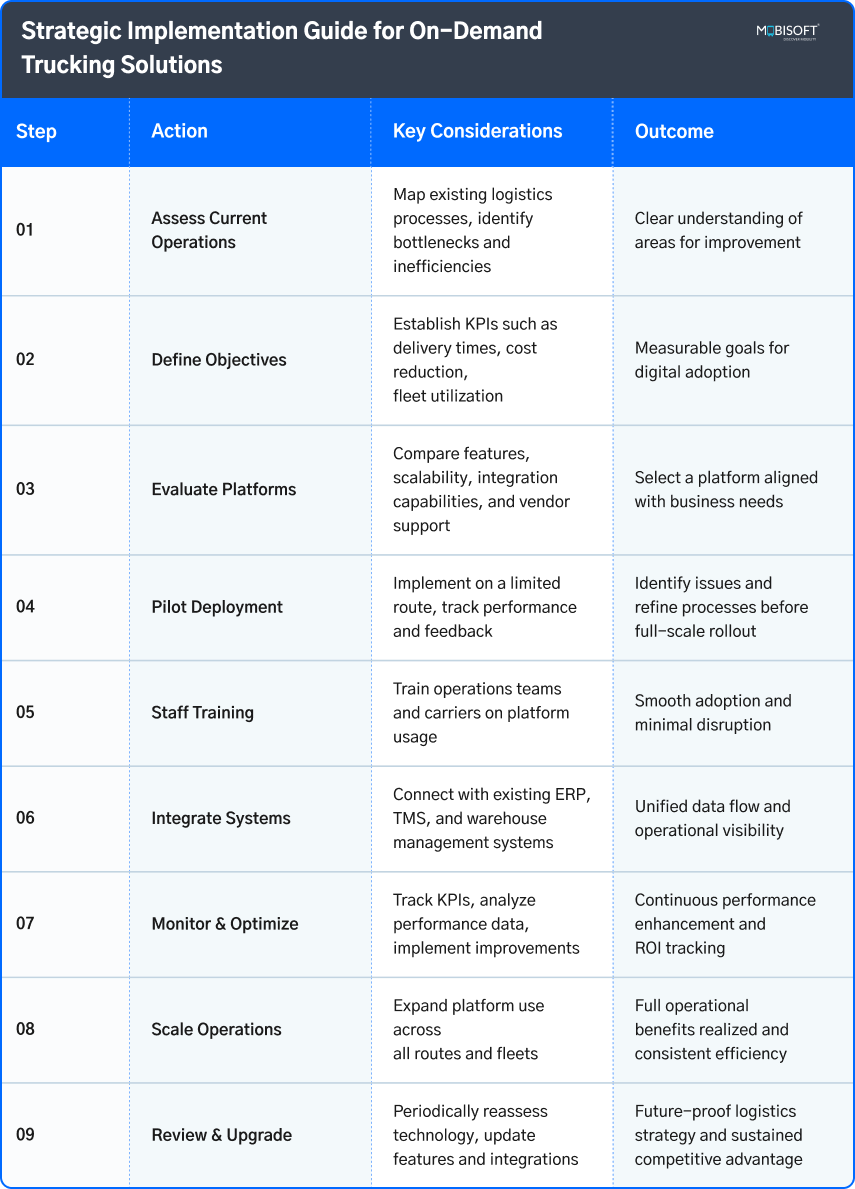
Implementing these on-demand trucking app solutions at every step immensely benefits organizations. This includes analytics, automated processes, and white-label trucking app solutions to scale faster.
This step-by-step approach helps enterprises integrate on-demand trucking app solutions effectively while leveraging automation, analytics, and white label trucking app solutions for faster scaling.
If you're ready to take the next step, explore how our on-demand app development services can help you build your on-demand trucking app from concept to launch.
The Future of Logistics with On-Demand Trucking Apps
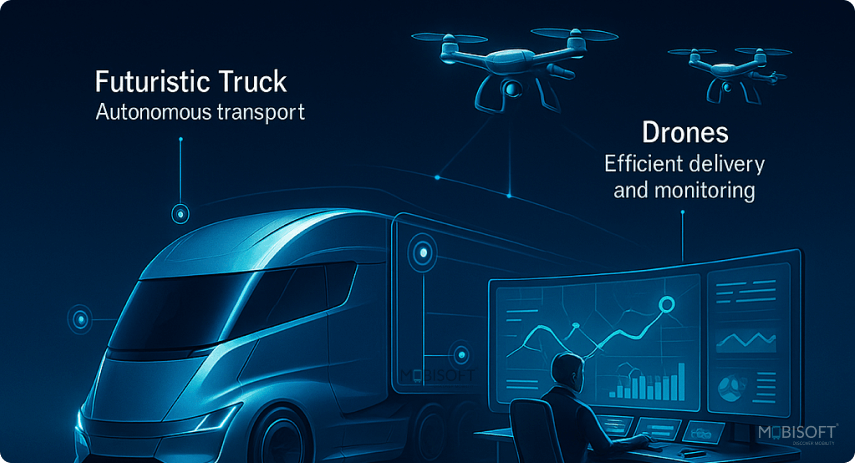
On-demand trucking apps capture and access data, offering important insights in real-time. These details greatly improve decision-making and enhance customer experience. Smart trucking solutions adopted by companies provide them with efficiency, besides a strategic advantage in planning, execution, and customer service.
Creating apps for trucking and logistics has become crucial to keep up with competitors. Companies can't ignore the transition from old-fashioned methods to modern software for managing logistics. Businesses that use AI and integrated digital platforms for freight have a chance to cut costs, ensure deliveries arrive on time, and make smart choices.
The future of logistics is digital, and companies that jump on board now will be in the best spot to do well in a market that values speed, openness, and quick responses.
Discover how companies are overcoming freight management challenges and implementing technology solutions to enhance logistics efficiency.
Key Takeaways
- The logistics sector is evolving out of traditional practices towards on-demand apps for trucking that provide real-time visibility, flexibility, and transparency in freight operations.
- The on-demand trucking business is going through rapid expansion as firms move from physical brokers to internet freight platforms that improve route efficiency and capacity utilization.
- Operational intelligence now enables improvements in logistics efficiency since predictive analytics allows organizations to forecast demand, reduce delays, and enhance decision-making processes.
- AI, IoT, and 5G technologies are developing the freight intelligence core by enhancing routing efficiency, real-time visibility, and instant data transfer between systems.
- On-demand trucking provides quantifiable, investable returns by reducing idle mileage, decreasing administrative expenses, generating customer confidence, as well as fostering sustainability for long-term operating.
- New-age models of brokerage are outpacing old-school brokers with transparency, speed, and flexibility that no system currently in place can match.
- Effective implementation of on-demand trucking technology allows firms to future-proof logistics activities.
- Those who embrace digital freight systems in today's world will obtain a sustainable competitive advantage in a data-driven, automated, and flexible industry.

FAQs
Are on-demand trucking apps more expensive than classical models of logistics? If yes, how beneficial is it?
Initial development for on-demand truck apps is indeed quite costly, ranging anywhere from $30,000 to over $200,000 based on features and complexity. Companies applying digital logistics, however, have reported reducing costs of operations by as much as 30% as opposed to existing freight technologies.
What contribution does artificial intelligence make towards improving freight management with such uses?
AI analyzes real-time to find the optimal routes, reduces commute hours by avoiding congestion ahead, and at the same time manages resources for overall efficiency.
How do IoT sensors help to provide increased transparency in logistics activities?
IoT devices seamlessly integrate with systems, allowing leaders to manage effectively. IoT devices also keep track of progress and environmental impacts, intervening immediately in case of bottlenecks.
What is the value of 5G connectivity for next-generation trucking technologies?
5G connectivity greatly improves data transmission and reduces latency, which is necessary for dynamic operations. It is what enables AI to work and report immediately.
What definite financial gains could organizations reap in making use of such apps?
Such companies minimize idle miles, rationalize schedules, reduce administrative costs, and maximize overall asset utilization, which amounts to hard-dollar cost reductions and return on investment.
What is the best method for implementing on-demand trucking services in a business enterprise?
A systematic approach that initiates with process analysis and employee education. Then comes implementation, system connectivity, and continuous improvements. These steps allow for easy integration as well as further benefits for operations.

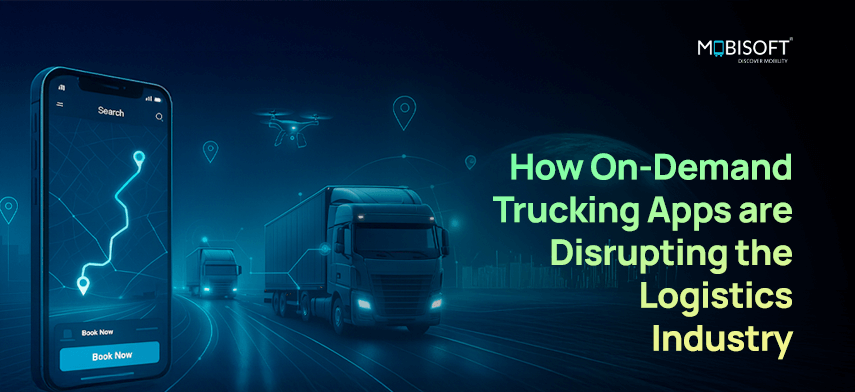


 October 3, 2025
October 3, 2025


